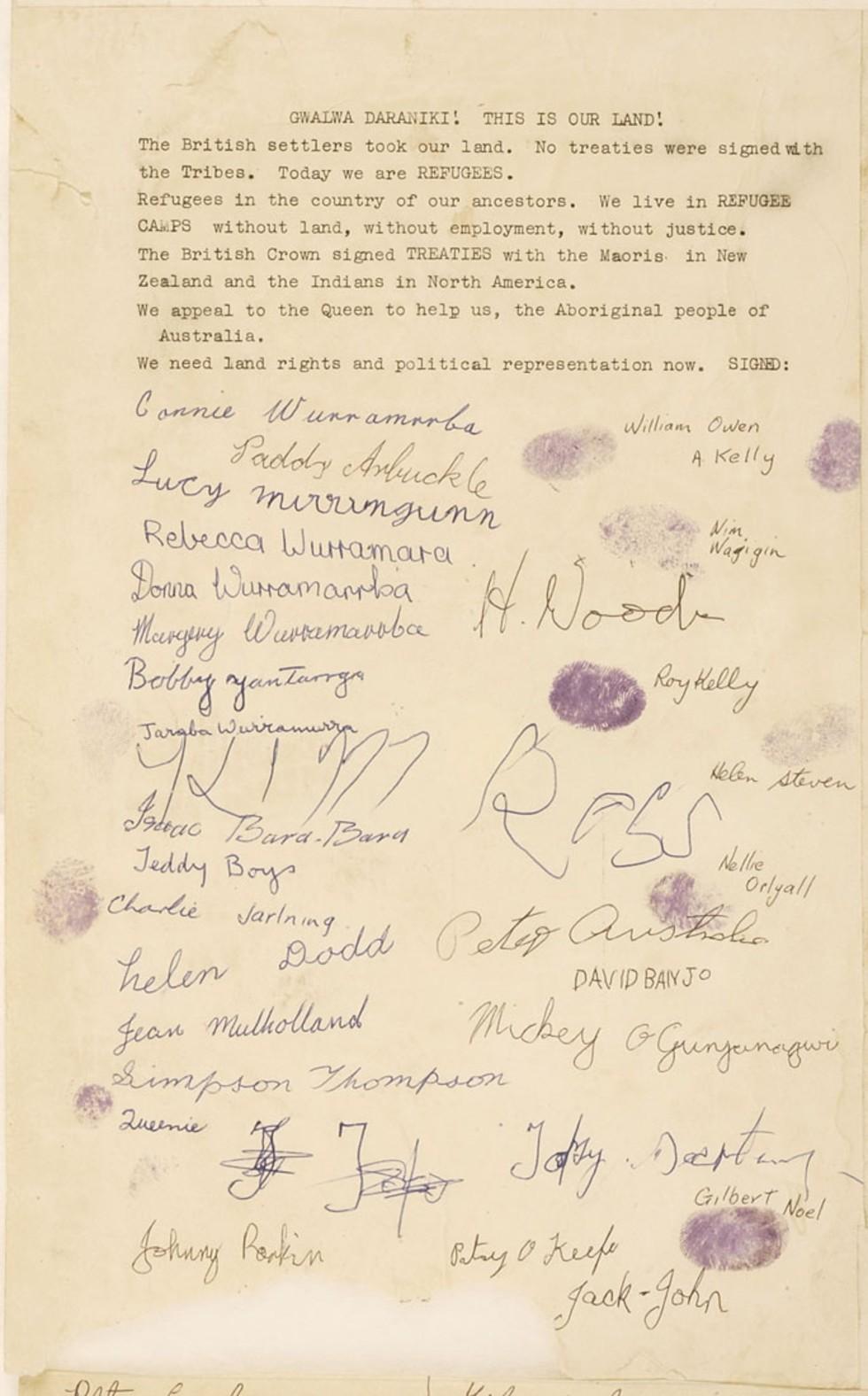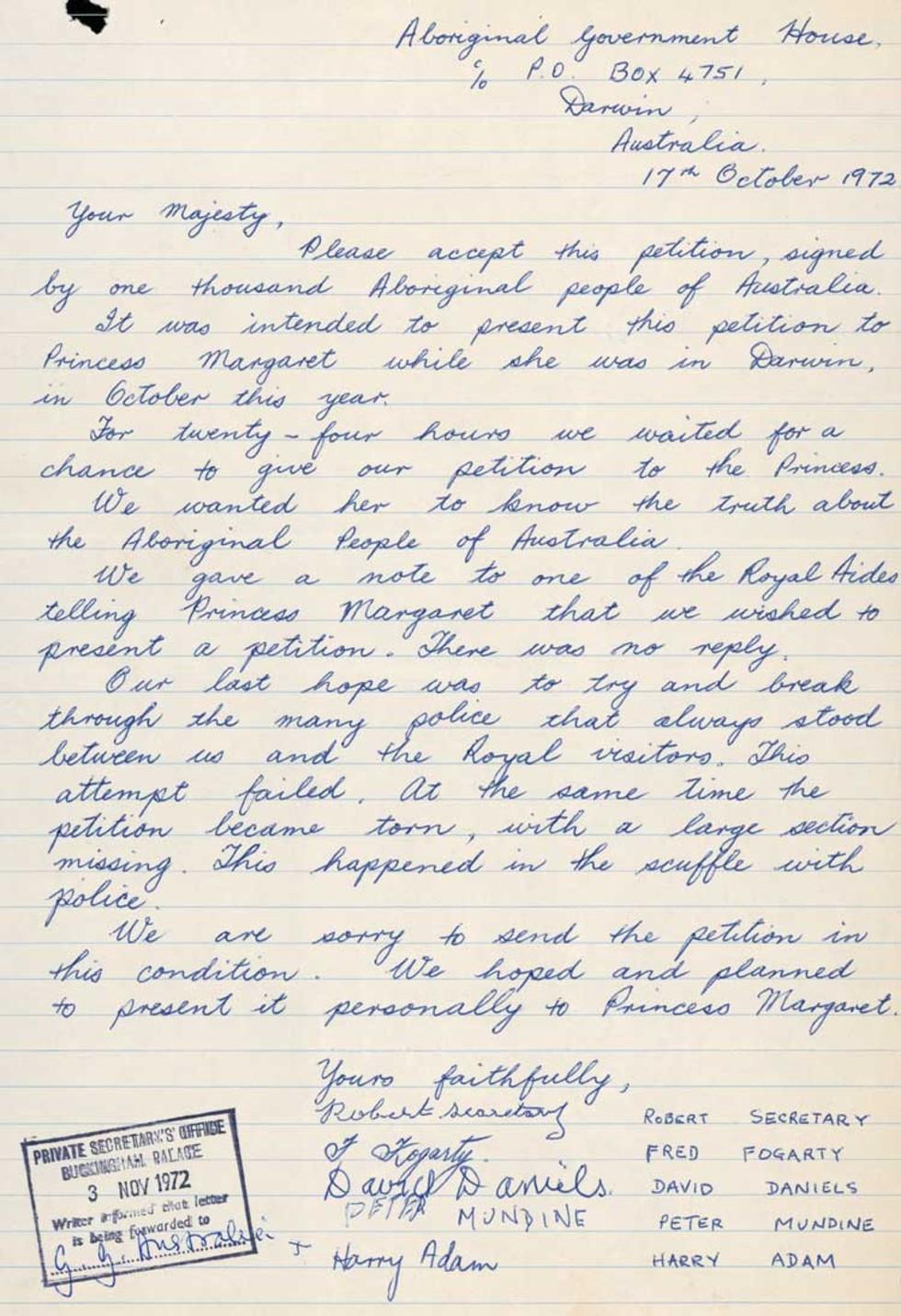


Aboriginal and Torres Strait Islander people should be aware that the National Archives' website and collection contain the names, images and voices of people who have died.
Some records include terms and views that are not appropriate today. They reflect the period in which they were created and are not the views of the National Archives.




(Petition Page 1)
Gwalwa Daraniki!
This is Our Land
The British settlers took our land. No treaties were signed with the tribes. Today we are REFUGEES.
Refugees in the country of our ancestors. We live in REFUGEE CAMPS – without land, without employment, without justice.
The British Crown signed TREATIES with the MAORIS in New Zealand and the Indians in North America.
We appeal to the Queen to help us, the Aboriginal people of Australia.
We need land rights and political representation now. SIGNED:
This record is a petition created by the Larrakia people in 1972. The Larrakia people are traditional owners of the Darwin region in the Northern Territory. At the time of this petition, they were fighting for their ownership of Kulaluk – a stretch of coastal land near Darwin – to be acknowledged.
A petition is a written request for change, addressed to someone in authority and signed by a number of people. The Larrakia people addressed this petition to Queen Elizabeth II.
The first image in this set shows the start of the petition. This includes the written request for change. It opens with the words GWALWA DARANIKI! which means 'our land' in the language of the Larrakia people. The petition goes on to state that:
The petition appeals to the Queen for help and concludes with two demands: land rights and political representation now.
A treaty is a legally binding agreement between two groups. For example, In New Zealand British colonisers signed the treaty of Waitangi with Maori rangatira (chiefs) in 1840. Today, the treaty is considered a significant constitutional document in New Zealand.
By contrast, the British didn't try to negotiate an agreement with Indigenous people in Australia. Today, Australia is the only Commonwealth country to have never signed a treaty with First Nations people.
To create this petition, Larrakia people organised for papers to circulate to Aboriginal communities across mainland Australia. In these communities, supporters of the petition signed the paper with either their signature or a thumb print. Over 1000 signatures and thumb prints were collected.
The papers were then returned to Darwin, where the finished petition was pasted together in a more than 3-metre-long scroll. The second image in this set shows some of the many signatures and thumb prints that can be found on the scroll.
In 1972, a royal visit to Darwin was planned for Princess Margaret, Queen Elizabeth II's sister. The Larrakia people camped outside Government House where she was staying, hoping for an opportunity to hand the petition to her personally. They were determined to use the petition as a strategy to publicise their struggle for land rights and put pressure on the Australian Government.
The police set up barriers outside Government House. They wanted to stop those camped outside from handing the petition to Princess Margaret. Damage to the petition occurred when the people carrying it tried and failed to break through the police barrier to deliver it.
After the plan to personally hand the petition to Princes Margaret failed, the Larrakia people patched the torn petition with adhesive tape and mailed it to Buckingham Palace. The third image in this set shows the letter they included with the petition. In it, they apologise for the condition of the petition and explain how the damage was sustained in the scuffle with police.
When Buckingham Palace received the petition, they forwarded it to the Australian government via the Governor General. It was placed on file in the Department of Aboriginal Affairs in 1972. This is how it became a government record and part of the collection at the National Archives of Australia.
The Larrakia petition is one of the most significant documents created by First Nations activists in the 1970s. The calls for change made by the petition – including land rights, treaty, and political representation – continue to have political significance today.
In 2013 a facsimile of the petition was presented to the Larrakia Nation Aboriginal Corporation. The original is preserved in the National Archives' collection.
Learning resource text © Education Services Australia Limited and the National Archives of Australia 2010.
Learn how to interpret primary sources, use our collection and more.
